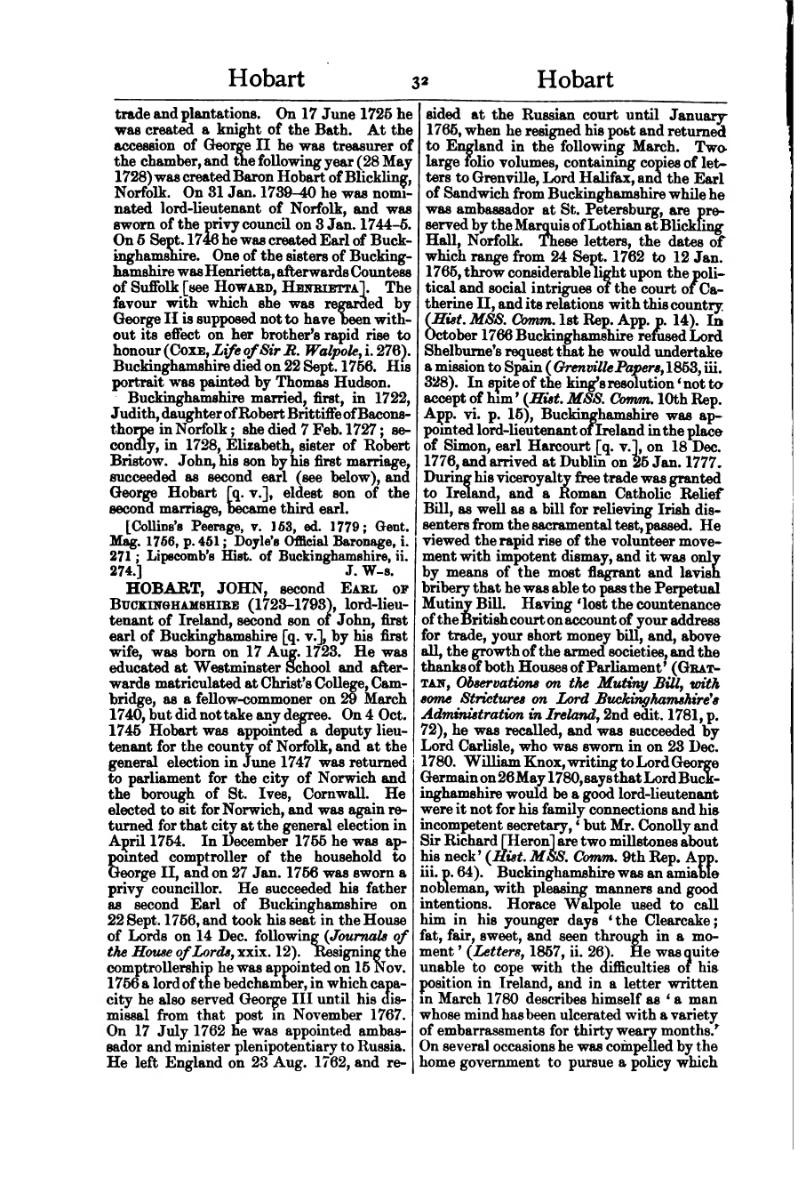trade and plantations. On 17 June 1725 he was created a knight of the Bath. At the accession of George II he was treasurer of the chamber, and the following year (28 May 1728) was created Baron Hobart of Blickling, Norfolk. On 31 Jan. 1739–40 he was nominated lord-lieutenant of Norfolk, and was sworn of the privy council on 3 Jan. 1744–5. On 5 Sept. 1746 he was created Earl of Buckinghamshire. One of the sisters of Buckinghamshire was Henrietta, afterwards Countess of Suffolk [see Howard, Henrietta]. The favour with which she was regarded by George II is supposed not to have been without its effect on her brother's rapid rise to honour (Coxe, Life of Sir R. Walpole, i. 276). Buckinghamshire died on 22 Sept. 1756. His portrait was painted by Thomas Hudson.
Buckinghamshire married, first, in 1722, Judith, daughter of Robert Brittiffe of Baconsthorpe in Norfolk; she died 7 Feb. 1727; secondly, in 1728, Elizabeth, sister of Robert Bristow. John, his son by his first marriage, succeeded as second earl (see below), and George Hobart [q. v.], eldest son of the second marriage, became third earl.
[Collins's Peerage, v. 153, ed. 1779; Gent. Mag. 1756, p. 451; Doyle's Official Baronage, i. 271; Lipscomb's Hist. of Buckinghamshire, ii. 274.]
HOBART, JOHN, second Earl of Buckinghamshire (1723–1793), lord-lieutenant of Ireland, second son of John, first earl of Buckinghamshire [q. v.], by his first wife, was born on 17 Aug. 1723. He was educated at Westminster School and afterwards matriculated at Christ's College, Cambridge, as a fellow-commoner on 29 March 1740, but did not take any degree. On 4 Oct. 1745 Hobart was appointed a deputy lieutenant for the county of Norfolk, and at the general election in June 1747 was returned to parliament for the city of Norwich and the borough of St. Ives, Cornwall. He elected to sit for Norwich, and was again returned for that city at the general election in April 1754. In December 1755 he was appointed comptroller of the household to George II, and on 27 Jan. 1756 was sworn a privy councillor. He succeeded his father as second Earl of Buckinghamshire on 22 Sept. 1756, and took his seat in the House of Lords on 14 Dec. following (Journals of the House of Lords, xxix. 12). Resigning the comptrollership he was appointed on 15 Nov. 1756 a lord of the bedchamber, in which capacity he also served George III until his dismissal from that post in November 1767. On 17 July 1762 he was appointed ambassador and minister plenipotentiary to Russia. He left England on 23 Aug. 1762, and resided at the Russian court until January 1765, when he resigned his post and returned to England in the following March. Two large folio volumes, containing copies of letters to Grenville, Lord Halifax, and the Earl of Sandwich from Buckinghamshire while he was ambassador at St. Petersburg, are preserved by the Marquis of Lothian at Blickling Hall, Norfolk. These letters, the dates of which range from 24 Sept. 1762 to 12 Jan. 1765, throw considerable light upon the political and social intrigues of the court of Catherine II, and its relations with this country (Hist. MSS. Comm. 1st Rep. App. p. 14). In October 1766 Buckinghamshire refused Lord Shelburne's request that he would undertake a mission to Spain (Grenville Papers, 1853, iii. 328). In spite of the king's resolution ‘not to accept of him’ (Hist. MSS. Comm. 10th Rep. App. vi. p. 15), Buckinghamshire was appointed lord-lieutenant of Ireland in the place of Simon, earl Harcourt [q. v.], on 18 Dec. 1776, and arrived at Dublin on 25 Jan. 1777. During his viceroyalty free trade was granted to Ireland, and a Roman Catholic Relief Bill, as well as a bill for relieving Irish dissenters from the sacramental test, passed. He viewed the rapid rise of the volunteer movement with impotent dismay, and it was only by means of the most flagrant and lavish bribery that he was able to pass the Perpetual Mutiny Bill. Having ‘lost the countenance of the British court on account of your address for trade, your short money bill, and, above all, the growth of the armed societies, and the thanks of both Houses of Parliament’ (Grattan, Observations on the Mutiny Bill, with some Strictures on Lord Buckinghamshire's Administration in Ireland, 2nd edit. 1781, p. 72), he was recalled, and was succeeded by Lord Carlisle, who was sworn in on 23 Dec. 1780. William Knox, writing to Lord George Germain on 26 May 1780, says that Lord Buckinghamshire would be a good lord-lieutenant were it not for his family connections and his incompetent secretary, ‘but Mr. Conolly and Sir Richard [Heron] are two millstones about his neck’ (Hist. MSS. Comm. 9th Rep. App. iii. p. 64). Buckinghamshire was an amiable nobleman, with pleasing manners and good intentions. Horace Walpole used to call him in his younger days ‘the Clearcake; fat, fair, sweet, and seen through in a moment’ (Letters, 1857, ii. 26). He was quite unable to cope with the difficulties of his position in Ireland, and in a letter written in March 1780 describes himself as ‘a man whose mind has been ulcerated with a variety of embarrassments for thirty weary months.’ On several occasions he was compelled by the home government to pursue a policy which
